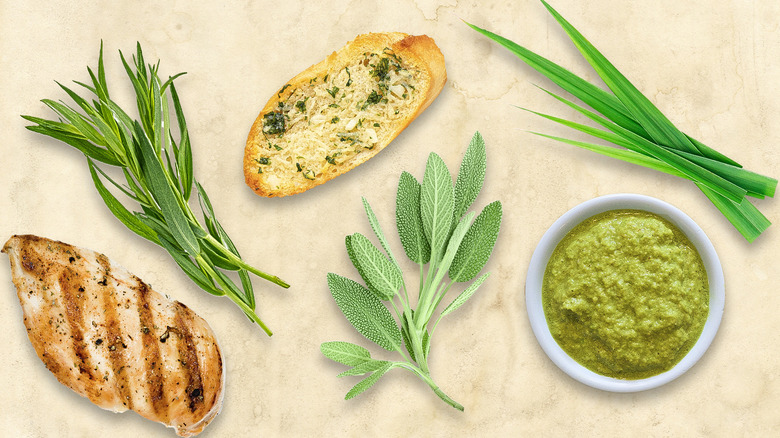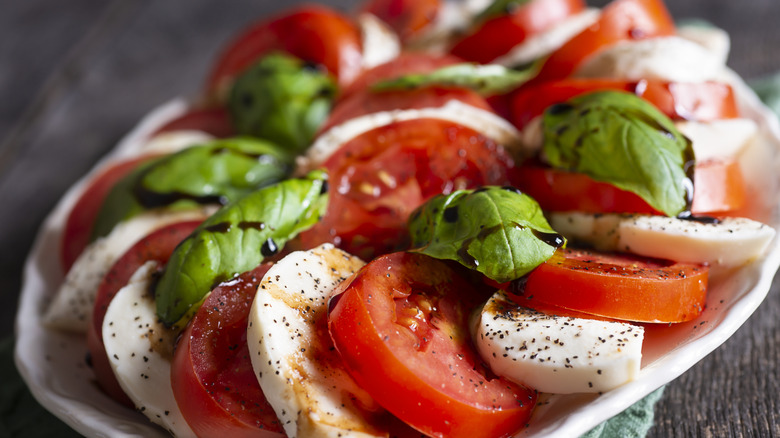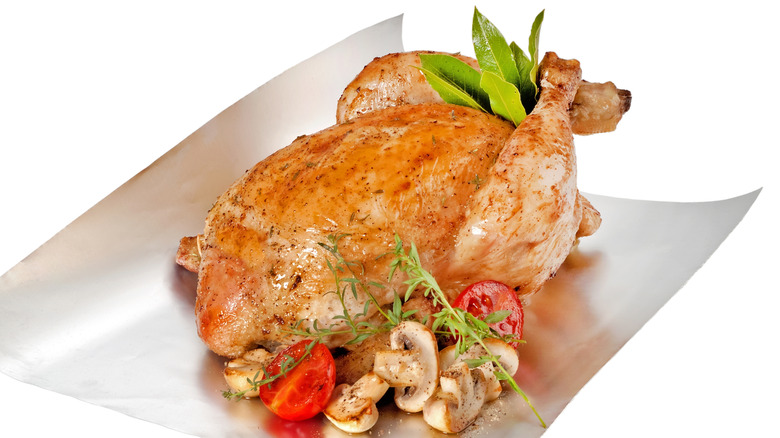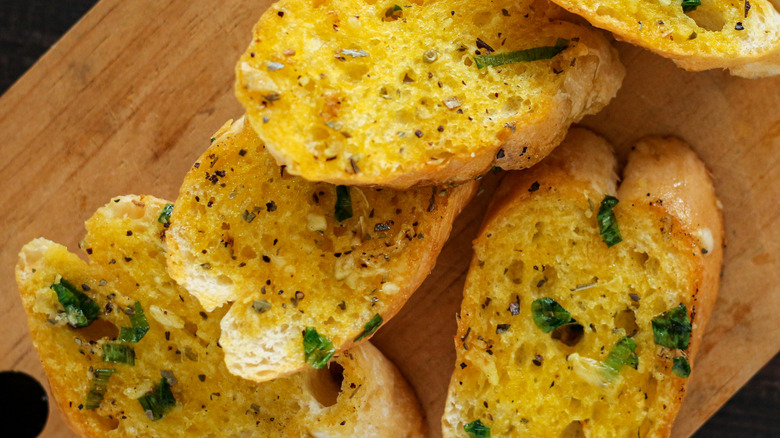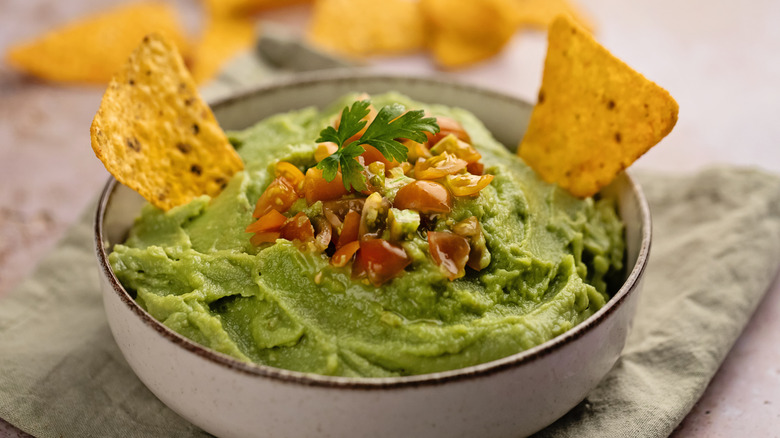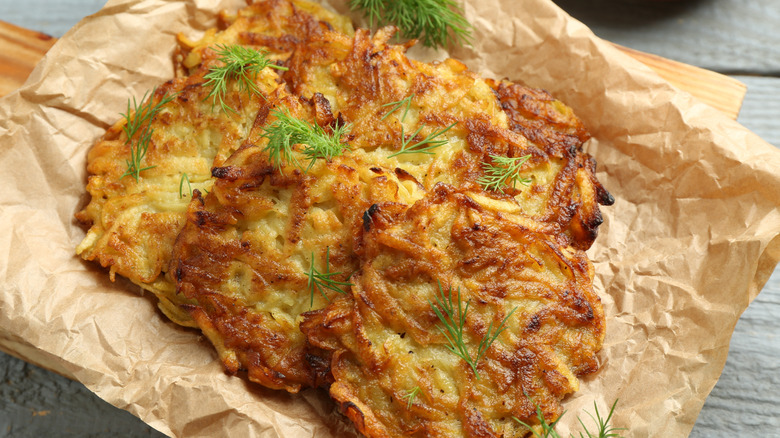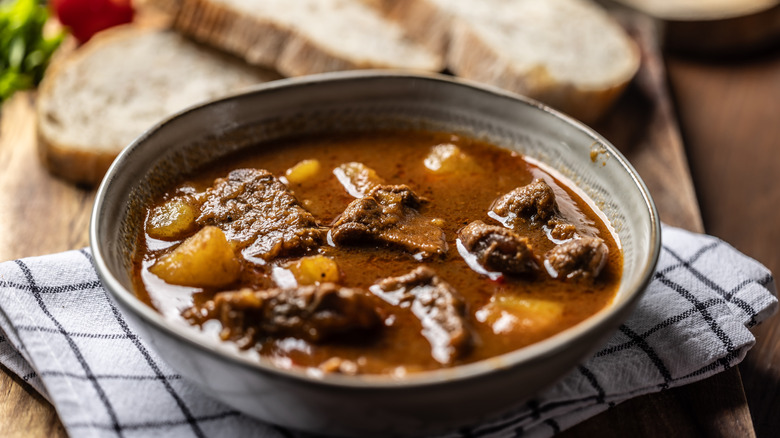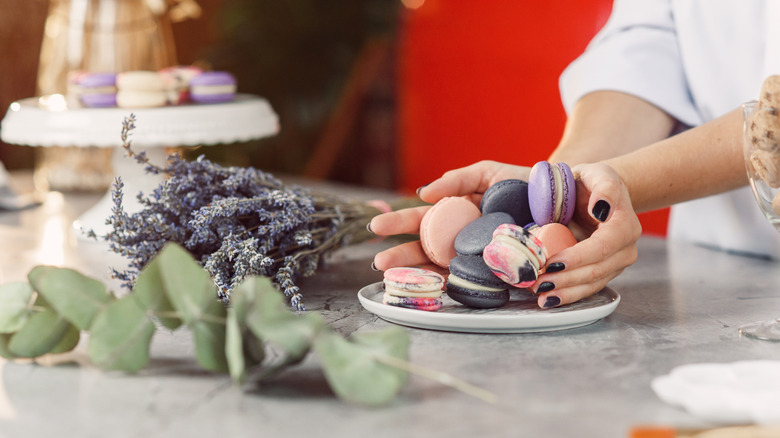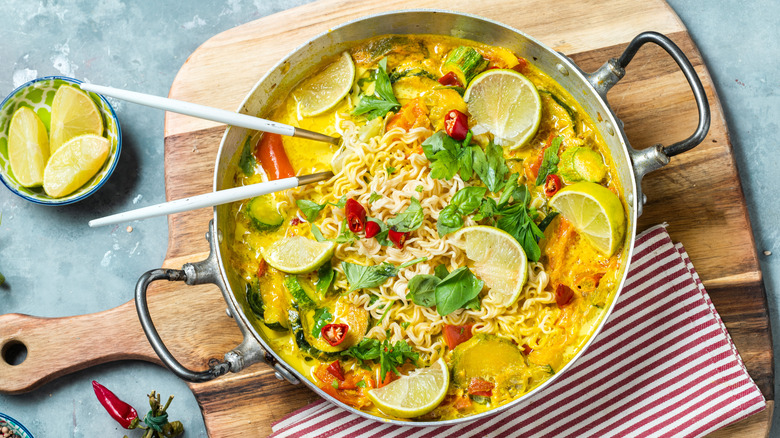How To Use 14 Popular Herbs To Their Full Potential
We may receive a commission on purchases made from links.
It's no secret that herbs pull their weight in the kitchen. Used across the world for tens of thousands of years, there's nothing they can't elevate: meats and veggies, drinks and desserts, and everything in between. From zingy mint to savory sage, these fresh greens can completely alter the flavor profile of a meal without asking much of the cook.
"Herbs are the easiest way I know to transform a dish without changing your technique or spending more," says Marissa Stevens, the recipe developer behind Pinch and Swirl. "That same roasted chicken can taste Mediterranean with oregano, French with tarragon, or Middle Eastern with sumac and parsley." Plus, she says, fresh herbs make even simple foods feel more thoughtful and more special than the usual weeknight rush.
"Herbs are pure kitchen magic," agrees Connie Edwards McGaughy, recipe developer at The Carrot Underground. "Just a handful can completely shift the mood of a dish, making it brighter, feel cozier, or add a depth of flavor you didn't even know was missing."
The question becomes, which herbs go with what? How can you use each to its full potential? There's a pretty good maxim for this, McGaughy says: "The phrase 'what grows together goes together' is often used when pairing food and wine." For instance, she says, potent pairings include Mexican-grown cilantro in Southwestern dishes, oregano with Italian flavors, or lemongrass in Southeast Asian cooking. Here are 14 herbs to help you level up your cooking today.
Basil and tomato
There are many ways to cook with basil, but pairing it with tomato is without doubt the most classic combination. Plus, it's one of the easiest herbs to grow in the garden, so knowing what to do with a bumper crop is a boon. "Basil's peppery, sweet aroma flawlessly complements the umami and acidity of the tomatoes," says Ken Tobby, founder of Organic Solace. "The basil's volatile oils elevate and brighten the tomato's natural sweetness, making the combination feel full-bodied and fresh." In fact, Marissa Stevens says, basil brings out the tomato's full flavor, making it taste even more like itself. "It's why caprese salad works even when it's only three ingredients," she says.
Although caprese salad is certainly one of the most beautiful ways to enjoy this combo, it's not the only one. "Basil leaves and tomatoes can be found paired in classic dishes such as tomato soup, tomato bocconcini, and Margherita pizza," says Rachael Miller, nutritionist and founder of Zhi Herbals. She cautions, though, that you should always use the right ratio when subbing fresh herbs for dry. "In most cooking and baking, dried herbs can be substituted for fresh with minimal impact on the finished recipe. Use ⅓ of the quantity if you are substituting with dried herbs."
Keep in mind, too, that some recipes, like caprese, do require fresh herbs. As for adding fresh basil to cooked foods, make sure to do it at the end to preserve basil's taste and color, says Kai Chase, culinary talent at Virtual Xperiences and Kevin Hart's current private chef.
Tarragon and chicken
Tarragon is a bit of a head-scratcher for some home chefs. It has a pleasant licorice flavor and aroma, but what exactly do you do with it? Turns out, a lot, but prime among the best applications for tarragon is to pair it with chicken. In fact, Ina Garten counts on tarragon to — as she would say — turn up the volume on her chicken salad.
Tarragon adds complexity to the flavor of chicken without overwhelming it, explains Kezia Joy, registered dietitian nutritionist at Welzo. "It's such arefined herb that adds an air of sophistication without overpowering the dish," she says. "When cooked, tarragon melts into a sweet-ish, aromatic background that rounds out creamy sauces and broths. It plays especially nicely in French-style treatments such as chicken in white wine or tarragon cream." It also helps you up the savory profile of chicken without adding gobs of salt or fat, Ken Tobby says, which is better for your health.
Sage and garlic bread
Baking with fresh herbs is a delicate art because herbs can quickly wilt and lose their flavor when exposed to high heat. To bake with herbs well, you'll need to choose hardy stock, and sage is nothing if not hardy. It has an earthy and slightly peppery flavor with citrus notes, says Nico Abello, corporate chef at Table 301 Hospitality. It pairs well with the pungent taste of alliums, making it a favorite addition to garlic bread.
"If you infuse the butter or olive oil with garlic and sage before incorporating it into the dough, it will intensify the flavors," he says. Of course, you can always sprinkle sage on top along with the butter, garlic, and parmesan mixture, too. Make sure to get salted butter, he says, which has the best flavor — 365 Everyday Value Organic Salted Butter is a good choice.
If you want an easier route, feel free to simply crisp up some sage leaves in the pan and serve it with your bread, Marissa Stevens says. When cooking or baking with sage, make sure you choose fresh, sturdy leaves that stand up straight in your hand and have no spotting or wilting. Fresh herbs are best for fresh flavor.
Cilantro and avocado
Although some people hate cilantro, for those who love it, there's nothing better to brighten up the flavors of guacamole and salsa. "Cilantro and avocado make such a natural pair because they offer different kinds of freshness," Connie Edwards McGaughy says. "Cilantro brings a peppery, citrusy bite, while avocado is smooth, rich, and mellow. The herb cuts through the creaminess, and the avocado softens the sharpness of cilantro. Each one balances the other."
These flavors work together in other dishes too, Nico Abello says. Put cilantro on your avocado toast, he advises, or blend avocado and cilantro together into a creamy Southwest salad dressing. "Add lime juice, garlic, and olive oil and it's perfection," he adds.
If you ever have trouble getting avocados out, there are tools online that help to cut them open, pit them, and slice them all in one go. The OXO Good Grips 3-in-1 Avocado Slicer is one example, but there are others as well.
Parsley in grain bowls
"Parsley is seriously underrated," Connie Edwards McGaughy says. "People often think of it as just a garnish, but it's so much more than that. Its fresh, grassy flavor brings balance to hearty grain bowls, adding brightness and a clean finish to ingredients like quinoa, farro, or bulgur." It adds color, texture, and earthiness all in one, pairing beautifully with lemon flavors, such as dressing for a classic tabbouleh salad.
Grain bowls serve as an excellent base for beans, vegetables, cheese, condiments, and — you guessed it — fresh herbs. If you're looking to up your bowl game, it's time to bring some ancient grains into the house. Play around with options, such as BetterBody Foods Organic Quinoa or Bob's Red Mill Organic Farro. You can also experiment with adding Duru Fine Bulgur to your salad for a powerhouse lunch including tons of nutrients and health benefits.
Rosemary in Bolognese
Cooking with rosemary always sounds like a good idea, but it can sometimes feel a bit inaccessible. The herb is tough, spiky, and somewhat demanding to prep properly. Prepared incorrectly, it can also be a bit overwhelming because rosemary has a bitter or piney flavor if you add too much and don't balance it with other flavors.
There are, however, wonderful ways to use rosemary at home, and classic Bolognese sauce is prime among them. This delicious recipe pairs fragrant onions, sweet carrots, meat, tomatoes, and herbs to create a thick, luscious sauce that coats noodles to perfection. Rosemary plays a starring role, giving depth and complexity to the final result that you just don't have without it. Just make sure to cut the herbs finely, which will release the oils that deliver those complex flavors, Ken Tobby says. A high-quality chef's knife, like the Paudin 8-Inch High Carbon Stainless Steel, can help you do this.
Dill and potatoes
There's a reason you see dill on potatoes. French potato salad, regular potato salad, sour cream mashed potatoes, and oven-roasted potatoes are just a few of the ways you can combine these two flavors to great effect, but why do they work so well together? "Dill adds the exact contrast potatoes need," Marissa Stevens replies. "Its grassy sharpness cuts through all that starch and richness, whether you're using butter, cream, or mayo. It makes something heavy feel lighter and sharper, especially in warm potato salads or creamy bakes."
The same goes for potato soup, Ken Tobby says. The dill's light taste brings an airiness to the dish that counteracts starchy heaviness, but without overriding the naturally earthy flavor we all love in potatoes. This combo works both hot and cold, Kezia Joy adds, so feel free to make use of it across temperatures, cuisines, and seasons.
Chive and biscuits
"Chives are onion's more polite cousin," Marissa Stevens says. "They bring that savory hit without any bite." This makes them perfect for baking with, adding an onion flavor to your biscuits, savory scones, hush puppies, and muffins without too much heat. Stevens adds that they hold up well to the process: "Unlike scallions or regular onions, they won't add extra moisture or turn bitter in the oven. I love how they stay green and bright, with little savory bursts in every bite."
Because they're so delicate, Ken Tobby adds, chives add a savory richness without overriding the biscuits' delicate and buttery flavor. Their small size also makes them easy to handle. "When mixed in biscuit dough, chives spread evenly, bringing aromatic brightness all through," he says. Make sure your chives are fresh, though. If you don't have them in the garden or growing in a pot, buy them at the grocery store and use them within a few days to preserve their color and flavor.
Oregano and tomato sauce
An enthusiastic denizen of the garden and a delicious adder of savory flavor in the kitchen, oregano is the perfect companion for gardener cooks who love snipping fresh herbs right out the back door — and nothing pairs more wonderfully with oregano than tomatoes. "Oregano is slightly peppery and has an earthy flavor that goes well with the sweetness and acidity of tomatoes, making sauces taste fuller and more aromatic," Nico Abello says. "In Italian cuisine, fresh oregano brings an herbal touch, while dried oregano delivers a concentrated, slightly smoky essence."
Kai Chase affirms their amazing partnership. "Together, they create the quintessential base for pizzas and pasta, providing a robust flavor that is familiar and comforting," she says. When you're using oregano, though, be sure to use the right type and the right amounts. It gets bitter if overpowering, so don't go hog-wild. Also, dried oregano is sweeter and earthier, while fresh is peppery and zingy, so try to avoid substituting them if you can: You won't get the same result.
Another important tip is to use high-quality tomatoes. There's no point in sourcing fresh, beautiful oregano only to pair it with subpar canned tomatoes that don't have any flavor (or worse, that taste like aluminum and nothing else). There's a reason chefs use products like Cento Certified San Marzano Whole Peeled Tomatoes — they're not too expensive and they get the job done, so take note.
Bay leaf and stews
"Bay leaves are subtle, but they make a big impact in slow-cooked dishes like soups and stews," Connie Edwards McGaughy says. "They add a savory, slightly herbal undertone that builds gradually as the dish cooks. You may not taste them outright, but you'd definitely notice if they weren't there." If you doubt this, make a dish that traditionally calls for bay leaves — say, French onion soup — with and without them, then taste the difference. Trust this writer (who has done the experiment): you'll taste it.
Remember, Kai Chase says, "Dried herbs are more concentrated because the moisture has been removed, yielding a more potent, sometimes earthy flavor. They should be added earlier in the cooking process to allow time for their flavor to release and infuse into the dish." Just make sure you pull that bay leaf out when you're ready to serve. "Biting into a bay leaf is no one's idea of a good surprise," McGaughy says.
Note that while you probably associate bay leaves with the dried version that comes in a jar, you can purchase bay leaves fresh and some recipes do call for this. Amazon Grocery Organic Bay Leaves are sold fresh and refrigerated, so you can get the most of their flavor in your soups and stews. Although bay might seem exotic to the uninitiated, the culinary bay or bay laurel (Laurus nobilis) is actually suited to many temperate gardens, thriving in USDA hardiness zones 7 through 10.
Lavender and cookies
This writer will never forget learning that Kate Middleton ate lavender biscuits while pregnant as a cure for morning sickness. Seriously, is there anything more demure than that? As it happens, lavender is almost tailor-made for cookies. "Lavender provides a mild floral note that beautifully combines with butter and sugar in baked products," Ken Tobby says. "When utilized sparingly, lavender lends a complex aroma that enhances simple treats into something fragrant and elegant."
Because it has such a robust flavor profile, though, lavender is best when it can shine on its own, Rachael Miller adds. That's why you should choose more neutral bases, such as sugar cookies or white bread if you want to bake with lavender. It will also enhance vanilla, honey, and lemon flavors, Kezia Joy says. Just remember that a little goes a long way: "It's better when used dry and sifted, or infused into milk or butter, to achieve a more homogeneous flavor throughout the dough."
Another way to add lavender to your baked goods is to infuse it into honey to drizzle on scones, as Connie Edwards McGaughy does. This keeps it from becoming overpowering or soapy tasting. It's easier to control the flavor if you add lavender honey to your already baked scone a little at a time. "It's absolutely lovely with warm scones or biscuits for afternoon tea," McGaughy says.
Lemongrass and curry
"Lemongrass has a citrusy, slightly floral aroma with hints of ginger," Nico Abello says. Together, lemongrass and curry make up a common flavor profile of Thai and other Southeast Asian cuisines, especially in coconut-based curries, where they play a zesty, lively role. "When simmered in a curry, lemongrass infuses the dish with a brightness that balances the richness of coconut milk, turmeric, cumin, and chilies," Abello says.
"Lemongrass brings a fresh, lemony brightness that lifts and lightens rich curry dishes," Connie Edwards McGaughy agrees. However, make sure you give the stalks proper treatment so that people don't end up chewing on them later, she warns. "Since the stalks can be tough and fibrous, I bundle them with other herbs into a sachet in cheesecloth before simmering them in soups or curry. That way, all the flavors infuse into the dish, and it's easy to remove the lemongrass sachet before serving."
Note that there aren't any truly convincing substitutes when cooking with lemongrass. If you want to make a curry recipe and can't find it at your local Asian grocery, there are a few ingredients that may give you similar flavors including actual lemon, lime, cilantro, or Kaffir lime leaves.
Mint and chocolate
If you don't love mint and chocolate together, who even are you? They're seriously a match made in heaven, as everything from mint chocolate chip ice cream to grasshopper pie proves, and there's a reason the combo works so well. "Mint changes how chocolate tastes," Marissa Stevens says. "Its menthol coolness resets your palate between bites, so the richness doesn't get cloying. The trick is restraint — you want that clean, fresh contrast, not something that overpowers the chocolate."
Similarly, Rachael Miller explains that mint helps to cut through the chocolate's heavier and fattier qualities. Adding just a bit of mint can lead to a more balanced result for your dessert, with a clean finish. Plus, Kai Chase says, it's just so darn classy: "This pairing is often associated with indulgence and sophistication, making it a favorite in confections and baked goods."
Chervil and eggs
Chervil, also known as French parsley, is a unique herb. Described as a flavor combination of parsley and tarragon, chervil's ever-so-delicate flavor is the perfect balance to a plate of scrambled eggs. A beautiful combination of chives, cream cheese, farm-fresh eggs, and chervil is the ideal breakfast or brunch for someone who wants both protein and a bit of class. Chervil isn't always easy to find, however, so you can either source a dried version (such as Spices Village Fresh Dried Chervil) or grow your own (such as with Non-GMO Heirloom Chervil Seeds for Planting).
At the end of the day, Kai Chase says, incorporating herbs into your meals can enhance both taste and nutrition. "Whether fresh or dried, they can add depth, complexity, and a burst of freshness to any recipe," she says. "They can transform a simple dish into something extraordinary, making them essential for chefs and home cooks alike."
